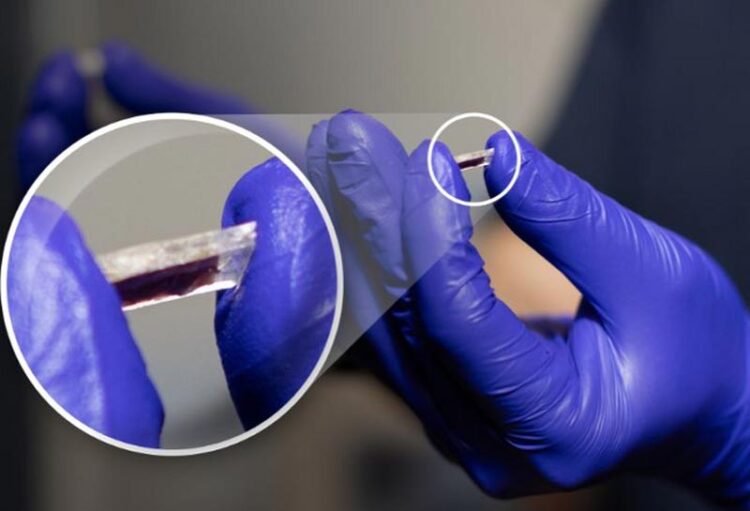Sensors that operate at high temperatures and in extreme environments

University of Houston researcher holding a newly developed piezoelectric sensor that has been proven to work at extremely high temperatures.
Credit: University of Houston
Sensitive, reliable and durable sensors created for multiple industries.
Extreme environments in several critical industries – aerospace, energy, transportation and defense – require sensors to measure and monitor numerous factors under harsh conditions to ensure human safety and integrity of mechanical systems.
In the petrochemical industry, for example, pipeline pressures must be monitored at climates ranging from hot desert heat to near arctic cold. Various nuclear reactors operate at a range of 300-1000 degrees Celsius, while deep geothermal wells hold temperatures up to 600 degrees Celsius.
Now a team of University of Houston researchers has developed a new sensor that was proven to work in temperatures as high as 900 degrees Celsius or 1,650 degrees Fahrenheit, which is the temperature mafic volcanic lava, the hottest type of lava on Earth, erupts.
“Highly sensitive, reliable and durable sensors that can tolerate such extreme environments are necessary for the efficiency, maintenance and integrity of these applications,” said Jae-Hyun Ryou, associate professor of mechanical engineering at UH and corresponding author of a study published in the journal Advanced Functional Materials.
The article, which was featured on the cover of the journal, is titled “Piezoelectric Sensors Operating at Very High Temperatures and in Extreme Environments Made of Flexible Ultrawide-Bandgap Single-Crystalline AlN Thin Films.”
Making It Work
The UH research team previously developed III-N piezoelectric pressure sensor using single-crystalline Gallium Nitride, or GaN thin films for harsh-environment applications. However, the sensitivity of the sensor decreases at temperatures higher than 350 degrees Celsius, which is higher than those of conventional transducers made of lead zirconate titanate (PZT), but only marginally.
The team believed the decrease in sensitivity was due to the bandgap – the minimum energy required to excite an electron and supply electrical conductivity – not being wide enough. To test the hypothesis, they developed a sensor with aluminum nitride or AlN.
“The hypothesis was proven by the sensor operating at about 1000 degrees Celsius, which is the highest operation temperature among the piezoelectric sensors,” said Nam-In Kim, first author of the article and a post-doctoral student working with the Ryou group.
While both AlN and GaN have unique and excellent properties that are suitable for use in sensors for extreme environments, the researchers were excited to find that AlN offered a wider bandgap and an even higher temperature range. However, the team had to deal with technical challenges involving the synthesis and fabrication of the high-quality, flexible thin film AlN.
“I have always been interested in making devices using different materials, and I love to characterize various materials. Working in the Ryou group, especially on piezoelectric devices and III-N materials, I was able to use the knowledge I learned in my studies,” said Kim, who earned his Ph.D. in materials science and engineering from UH in 2022. His award-winning dissertation was on flexible piezoelectric sensors for personal health care and extreme environments.
“It was very interesting to see the process leading to the actual results and we solved the technical challenges during the development and demonstration of the sensor,” he added.
What’s Next?
Now that the researchers have successfully demonstrated the potential of the high-temperature piezoelectric sensors with AlN, they will test it further in real-world harsh conditions.
“Our plan is to use the sensor in several harsh scenarios. For example, in nuclear plants for neutron exposure and hydrogen storage to test under high pressure,” Ryou said. “AlN sensors can operate in neutron-exposed atmospheres and at very high-pressure ranges thanks to its stable material properties.”
The flexibility of the sensor offers additional advantages that will make it useful for future applications in the form of wearable sensors in personal health care monitoring products and for use in precise-sensing soft robotics.
The researchers look forward to their sensor being commercially viable at some point in the future. “It’s hard to put a specific date on when that might be, but I think it’s our job as engineers to make it happen as soon as possible,” Kim said.
Journal: Advanced Functional Materials
Subject of Research: Not applicable
Article Title: Piezoelectric Sensors Operating at Very High Temperatures and in Extreme Environments Made of Flexible Ultrawide-Bandgap Single-Crystalline AlN Thin Films.
Article Publication Date: 2-Mar-2023
Media Contact
Rashda Khan
University of Houston
rkhan20@uh.edu
All latest news from the category: Materials Sciences
Materials management deals with the research, development, manufacturing and processing of raw and industrial materials. Key aspects here are biological and medical issues, which play an increasingly important role in this field.
innovations-report offers in-depth articles related to the development and application of materials and the structure and properties of new materials.
Newest articles

Durable, Efficient, Sustainable: The Rise of Cerium Oxide Thermal Switches
Groundbreaking cerium oxide-based thermal switches achieve remarkable performance, transforming heat flow control with sustainable and efficient technology. Cerium Oxide-Based Thermal Switches Revolutionize Heat Flow Control Thermal switches, which electrically control…

How Industrial Robots are Reducing Emissions in Global Manufacturing
A new study explores the intersection of industrial automation and environmental sustainability, focusing on the role of industrial robots in reducing the carbon intensity of manufacturing exports. The research demonstrates…

Patients Can Heal Through Precise, Personalized Bioceramic Grafts
A recent review is transforming the landscape of craniomaxillofacial bone regeneration with the introduction of personalized bioceramic grafts. This pioneering research explores the fabrication and clinical potential of synthetic grafts…



